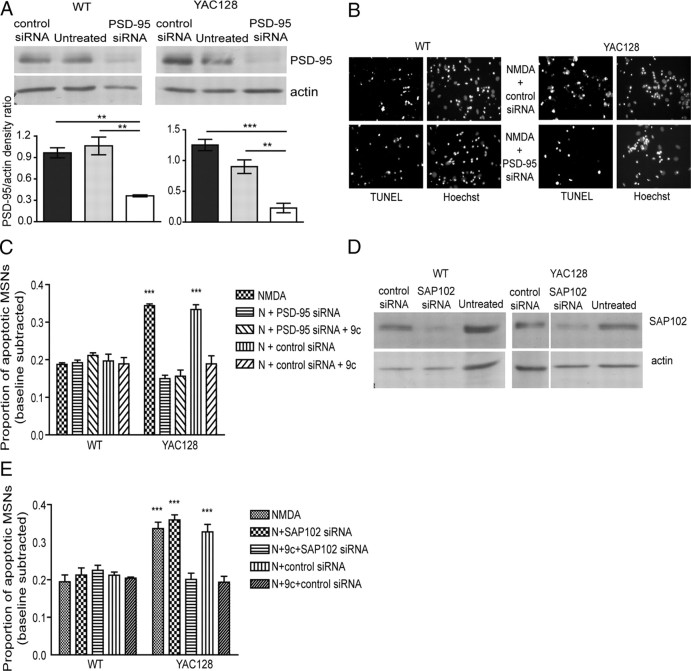Figure 5.
PSD-95 but not SAP102 knockdown by siRNA reduces NMDA toxicity in YAC128 MSNs but not WT MSNs. A, Representative Western blots and pooled data showing the knockdown of PSD-95 expression in WT and YAC128 MSNs 72 h after addition of PSD-95 siRNA but not control siRNA to culture medium. **p < 0.01, ***p < 0.001, by one-way ANOVA and Bonferroni's post hoc tests (n = 3 for WT and YAC128). B, Representative photomicrographs showing TUNEL- and Hoechst-stained WT and YAC128 MSNs pretreated with control siRNA (top) or PSD-95 siRNA (bottom) 72 h before 10 min challenge of NMDA. C, The effect of PSD-95 knockdown by siRNA on NMDA-induced toxicity in WT and YAC128 MSNs. Average proportion of apoptotic MSNs are shown (mean values calculated after subtraction of percentage apoptosis in NMDA-untreated condition for each experiment). Two-way ANOVA revealed significant difference for genotype, treatment, and interaction, n = 3; F(1,20) = 22, p < 0.001 for genotype; F(4,20) = 25, p < 0.001 for treatment; F(4,20) = 29, p < 0.001 for interaction (***p < 0.001 by Bonferroni's post hoc tests). D, Representative Western blots showing the knockdown of SAP102 expression in WT and YAC128 MSNs 72 h after addition of SAP102 siRNA but not control siRNA to culture medium (n = 3 for WT and YAC128). E, The effect of SAP102 knockdown on NMDA-induced toxicity in WT and YAC128 MSNs. Average proportion of apoptotic MSNs are shown (mean values calculated after subtraction of percentage apoptosis in NMDA-untreated condition for each experiment). Two-way ANOVA revealed significant difference for genotype, treatment, and interaction; n = 3 for WT and n = 4 for YAC128; F(1,25) = 52, p < 0.001 for genotype; F(4,25) = 11, p < 0.001 for treatment; F(4,25) = 14, p < 0.001 for interaction (***p < 0.001 by Bonferroni's post hoc tests). 9c, NR2B9c, N, NMDA.

